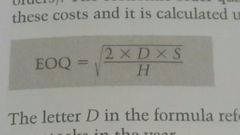![]()
![]()
![]()
Use LEFT and RIGHT arrow keys to navigate between flashcards;
Use UP and DOWN arrow keys to flip the card;
H to show hint;
A reads text to speech;
20 Cards in this Set
- Front
- Back
|
Inventory control |
managing the amount of stock held in a business |
|
|
Types of inventory |
- finished stocks waiting to be dispatched - raw material stocks held in stores for use in product manufacture - work in progress ( assembled goods and processed raw materials in the middle of the manufacturing process) |
|
|
Reasons for holding stock |
- as an insurance against higher than average demand to make sure that customer demands can be met -as an insurance against uncertain supplier delivery times (lead times) - to enable an organization to take advantage of price fluctuations (a company might buy in extra stock when prices are lower) - to take advantage of discount on bulk orders - to minimize production delays resulting from shortages |
|
|
Buffer stock |
The minimum amt of stock needed for production to carry on |
|
|
Draw stock control chart |

|
|
|
Economic order quantity |
The number of units a company should add to stock with each order to minimize the total costs of inventory |
|
|
Ordering cost |
The cost you have to pay the supplier to make a new order represented by S or C in the equation |
|
|
Lead time |
The normal time taken between ordering new stocks and their delivery |
|
|
Holding cost |
Cost of holding stocks in storage . Represented by H in the formula |
|
|
As the quantity of stocks increase, holding will ______ |
Rise |
|
|
As more stocks are held, the _____ the ordering cost |
Lower |
|
|
EOQ formula |

|
|
|
EOQ formula (from study guide) |

|
|
|
EOQ chart |

|
|
|
Inferences from EOQ chart |
-as the quantity of stock held increases, order and delivery cost decreases - as the stockholding increases, cost (of holding stock) increases -if order and delivery increases, cost increases -If stockholding decreases, cost of holding stock decreases |
|
|
Just in time |
A technique used to avoid holding stock by requiring suppliers to arrive at the production site just as they are needed to complete production of order |
|
|
Just in case |
A traditional approach to inventory management where a surplus or buffer stick of goods are created to supply customers. An excess of sully relative to demand |
|
|
Requirements for JIT |
- excellent relationship with suppliers - production staff must be multiskilled and prepared to change jobs at short notice -equipment and machinery must be flexible -accurate demand forecast - updated IT equipment -excellent employee -employer relationship |
|
|
Advantages of just in time |
- capital invested in inventory is reduced and the opportunity cost of stockholding is reduced - the stock has a lesser chance of becoming outdated / obsolete - cost of storage is released for other productive purposes - the greater flexibility that the system demands leads to quicker response times to changes in consumer demand / taste |
|
|
Disadvantages |
- failure to receive supplies of materials will lead to expensive production delays - delivery costs will increase as frequent small deliveries are an essential feature of HIT -Reduction in bulk discounts offered by suppliers -reputation of the business depends significantly on outside factors (suppliers, transportation) - |

